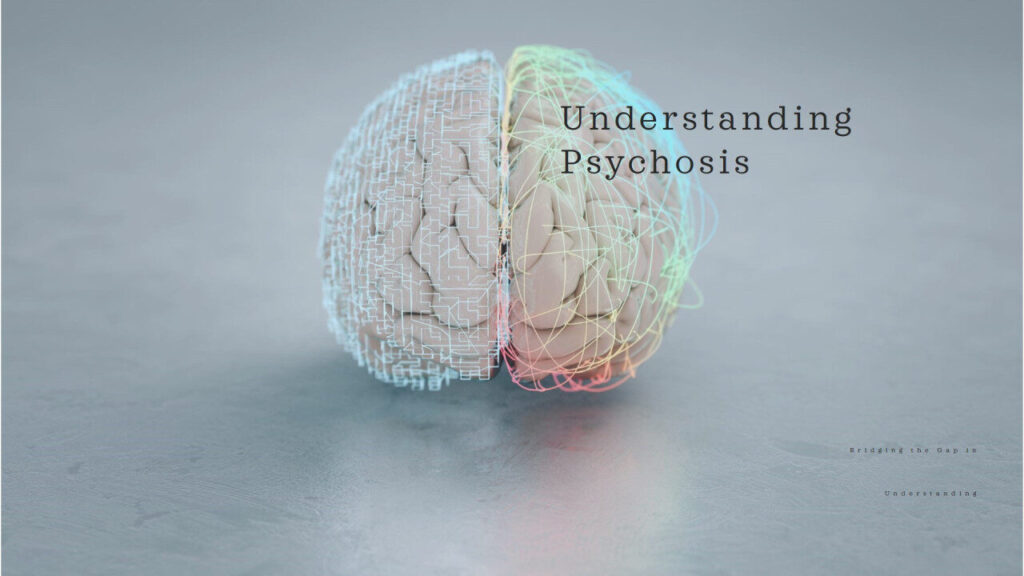Psychosis: Bridging the Gap in Understanding

Psychosis: Bridging the Gap in Understanding Imagine standing in the middle of a crowded street. People are walking by, chatting, laughing. But for you, everything feels different; unreal. The voices around you echo louder than they should. Shadows stretch and shift unnaturally. A single, repetitive thought whispers in your mind, so persistent it drowns out everything else: “Something isn’t right. Something is wrong.” For someone living with psychosis, this isn’t just a moment of anxiety or confusion. It’s an overwhelming storm, with no escape, where the lines between what is real and imagined blur into chaos. Despite its profound impact, psychosis remains one of the least understood and most feared aspects of mental health. Question: What Comes to Mind When You Hear ‘Psychosis’? Take a moment to reflect: When you hear the word ‘psychosis,’ what comes to your mind, to your thoughts? For many, it’s the dramatic headlines about someone “losing control” or a distorted Hollywood portrayal of violence and danger. These misconceptions are rooted in fear rather than fact; and they have cast a long shadow over what psychosis truly is: A deeply human experience marked by confusion, vulnerability, and pain. These myths don’t just misinform people; they alienate and push people struggling with psychosis further into silence, depriving them of the understanding and support they desperately need. The Cost of Silence and Stigma Psychosis is not a moral failing or a choice. It’s not an identity or a life sentence. But when society wraps it in layers of stigma, those living with psychosis are often left to carry an invisible weight that crushes their spirit. Families are torn apart by confusion and fear. Colleagues and managers withdraw out of discomfort, and individuals battling psychosis are left wondering if they will ever truly be seen or believed. But here’s the truth (one you may not understand or agree with): Silence kills. The shame bred by stigma leads to hesitation in seeking help, and that hesitation can mean the difference between life and death. We must do better, not just for those who live with psychosis but for the families, friends, and workplaces struggling to understand how to help. Why This Conversation Cannot Wait Psychosis can touch anyone, anywhere. It does not discriminate by age, race, or background. It’s not “someone else’s problem”; it’s a reality that could affect your friend, your colleague, your parent, or even yourself. Yet so few of us are equipped to offer the compassion, support, and action that can truly make a difference. In this post isn’t about tiptoeing around discomfort. It’s about stepping into it, breaking down the myths, and shining a light on what psychosis really is. I will: Take you beyond the stereotypes to explore the deeply human reality of psychosis. Offer insights into what it feels like to live in a world where reality itself is uncertain. Empower you with knowledge, and tools, to support those in need. Understanding psychosis is not just an academic exercise; it is a lifeline. Imagine being the person who offers hope when someone feels utterly lost. Imagine being the voice that says: “I see you. I believe you. I am here to help.” You can be that person. It starts here, with a willingness to learn, to feel, and to act. Let’s bridge the gap in understanding psychosis, not as a medical term, but as an experience that touches real people, in real lives, with real consequences. Remember: Every life matters. Every life deserves to feel seen, heard, and valued. What is Psychosis? Peeling Back the Layers Psychosis. The word alone carries weight. It’s a term that often evokes fear, misunderstanding, or even avoidance. How much of what we associate with psychosis is grounded in reality? For many, it conjures dramatic imagery, wild eyes, irrational behaviour, even violence. These portrayals, fuelled by media sensationalism and cultural myths, obscure the truth about what psychosis really is: a deeply human, profoundly isolating experience that touches far more lives than we realise. At its core, psychosis is not about “madness” or “danger.” It’s a state of mind where reality becomes blurred or distorted. A person experiencing psychosis may see, hear, or believe things that feel as real to them as the ground beneath their feet, even if those things don’t align with the shared reality of others. It’s not a sign of weakness or immorality; it’s a medical condition, and like any other medical condition, it deserves understanding and care. Breaking It Down: What Does Psychosis Involve? Psychosis is not a single symptom but rather a cluster of experiences that vary from person to person. At its heart, psychosis impacts perception, thought, and emotional connection to the world. Here’s what it often looks like: Delusions: These are unshakable beliefs that remain fixed despite conflicting evidence. For example: Someone may believe they are being followed by a government agency, even when there is no evidence to support it. They might think they have special powers or a unique purpose, such as being chosen to deliver an important message to the world. Importantly, delusions are not just “wild thoughts.” They are rooted in the person’s distorted perception of reality, making them deeply compelling and emotionally significant to the individual. Hallucinations: Hallucinations involve sensing things that others do not. These can occur across all five senses Hearing: Voices are the most common hallucination in psychosis. They might be critical, commanding, or conversational. For the person experiencing them, these voices can feel impossible to ignore. Seeing: Visual hallucinations, such as shadowy figures or distortions in light and colour, can also occur. Touch, Smell, and Taste: Less commonly, people may feel phantom touches, smell scents that aren’t there, or taste things that aren’t real. For the individual, these experiences are as vivid and convincing as anything else in their environment, making them emotionally and mentally overwhelming. Thought Disorders: Psychosis can also impact how thoughts are formed, processed, and expressed. This
